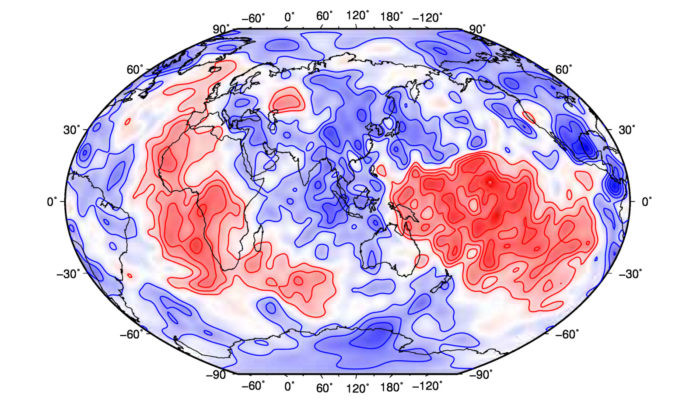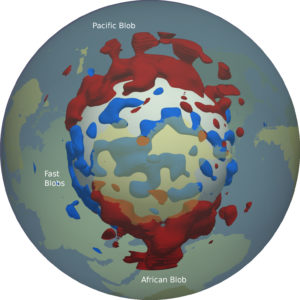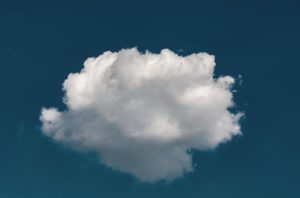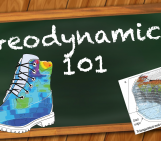
Normally I’d add some kind of clever remark here, but it’s just a figure full of blobs. What can I say about that? Maybe that dogs are better? Scroll down for a dog! So proud that we finally have dog content on this blog.
All blobs are equal, but some blobs are more interesting than other blobs. In this new Wit & Wisdom post, Jamie Ward, PhD student in seismology at the University of Leeds, United Kingdom, explores this age-old saying and discusses whether or not LLSVPs are the most important blobs in our lives. Also, there is a picture of a dog. It makes sense, I promise.

Large Low Shear Velocity Provinces (LLSVPs) have remained one of the most mysterious features of the Earth’s mantle since first observed in the 80s. Seismic tomography shows LLSVPs as colossal blobs slowing down seismic waves and sitting beneath Africa and the Pacific Ocean. Their location on the core-mantle boundary and their size puts them in arguably the best position to impact as much of the Earth as possible (the magnetic field, mantle convection and hotspot volcanism to name a few). Figure 1 shows the LLSVPs in 3-D with faster material between them.
Despite their hypothesised influence, the lack of understanding of LLSVPs beyond that we know they exist is staggering. A lot of time, effort, PhD tears, and grant money have been thrown at the problem over the past 30+ years, it must be said. So, this begs the question, what other blob like things are out there that are worth researching? Should money, effort, and tears be directed towards those instead? And ultimately:
Are LLSVPs the most interesting blobs to study?
Fortunately, this blog begins to address this question, which I’m sure everyone it thankful for.

Figure 1: -1 % (red) and +1 % (blue) δVs isocontours of tomography model SEMUCB-WM1 (French & Romanowicz, 2014).
Let’s start with other mantle blobs, mainly the fast material that lies between the LLSVPs and, the other common deep Earth acronym, Ultra Low Velocity Zones (ULVZs). The fast material is commonly thought to be ancient subducted slabs which have descended from the surface to the core-mantle boundary and now lie between LLSVPs (Figure 1). I would argue these fast blobs have been under-analysed and we have relatively few observations on their properties such as the velocity gradients at their boundaries etc. Understanding more about the fast blobs could lead to a better idea of what’s going on with the LLSVPs. Are they being swept into the LLSVPs? Why are they at the edges of LLSVPS? Who knows? I hope someone finds out. However, a non-insignificant amount of the impact of discovering more about the fast blobs is related to the understanding of LLSVPs. So, I’m disqualifying these blobs as the most-interesting blob for trying to piggyback off of the interest of LLSVPs.
Onto the ULVZs. These structures are arguably more enigmatic than the LLSVPs. They are small enough that they cannot be observed with seismic tomography and can slow down waves almost an order of magnitude more than LLSVPs. It seems to be an achievement to find locations where they do not exist as well as to actually observe them. They’re the annoying child who wants to play hide and seek all the time. Again, much to learn about ULVZs. Tiny blobs of ridiculously slow stuff lead to questions like: How did they get there? What processes were required? Does this rule out any other hypotheses of LLSVP formation? Do they interact with slab material? From an interest standpoint, they are definitely worth investigating. Unfortunately, like the fast blobs, I’m disqualifying them for mooching off of the LLSVPs’ fame.
Moving onto blobs that exist above the surface of the Earth. Clouds (Figure 2, in case you forgot what a cloud looks like) are, as far as I’m aware, blobs of water vapour and dust. I will admit, the role clouds play in the movement of water which then falls from the sky is important (boring people might call this rain). I might go as far as to say they are essential. On the other hand, how many weekend plans have been ruined by rain? How many animals terrified by thunder and how much damage from lightning? Now, has an LLSVP ever terrified any animals? Destroyed any structures? Ruined any weekend plans (not including having to work on the weekend)? No. I think it’s pretty clear who the winner is here (LLSVPs).

Figure 2: Image of a cloud. Photo by C Dustin on Unsplash.
While mulling over the other blob-like things which exist in this world, I came to a revolutionary realisation (at least revolutionary in terms of this blog). Literally anything can be a blob if you reduce the resolution or just squint your eyes. A dog, for example, can become a blob like thing (a dog-blob if you will) if you blur the original image – see Figure 3. Now, I am not going to go into much detail beyond this because this goes beyond the scope of this blog. The possibilities for this are seemingly endless. Everything is a blob from another perspective. Me, you, the computer, your work, we’re just a collection of blobs on top of a giant blob with more blobs inside it. Really, the study of these blobs is probably more important than LLSVPs, but I think that’s basically the whole field of physics…

Figure 3: Unblurred and blurred image of a dog illustrating the dog-blob concept. Photo by Fabian Gieske on Unsplash.
Anyway, now that we have explored several options, I’d like to end on a slightly more serious note. As a seismologist, I’m interested in providing more observations which are useful for other researchers to then constrain what is going on in the Earth and particularly the deep stuff (hi geodynamicists!). A lot of focus has been on the properties of LLSVPs and relatively little on the surrounding faster material. Narrowing down the density, morphology or “sharpness” of the boundaries, could then contribute to understanding the mantle including LLSVPs. Also, they’re cool, which I think is a solid reason to investigate them anyway.
References French, S.W. and Romanowicz, B.A., 2014. Whole-mantle radially anisotropic shear velocity structure from spectral-element waveform tomography. Geophysical Journal International, 199(3), pp.1303-1327. Ritsema, J., Deuss, A.A., Van Heijst, H.J. and Woodhouse, J.H., 2011. S40RTS: a degree-40 shear-velocity model for the mantle from new Rayleigh wave dispersion, teleseismic traveltime and normal-mode splitting function measurements. Geophysical Journal International, 184(3), pp.1223-1236.



